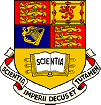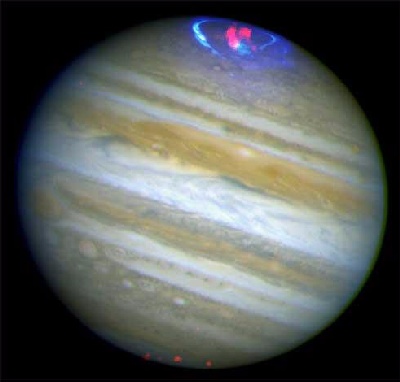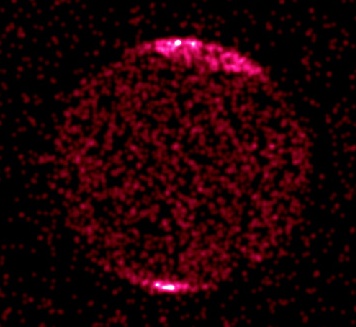
 |
|
News Page |

March 2002 |
This month's news stories:Cassini press release |
In late 2000 and early 2001 the Cassini spacecraft, on which the group leads the magnetometer experiment, performed a flyby of Jupiter on its way to Saturn (see SPAT News February 2001). The results of this unique flyby were published in the 28th February 2002 issue of the journal Nature. Michele Dougherty of SPAT is a co-author on three of these papers. In recognition of the important Imperial College contribution to the new findings, the college has marked the publication with a press release.
 |
This composite image displays X-ray data from Chandra (magenta) and ultraviolet data from Hubble Space Telescope (blue) overlaid on an optical image of Jupiter. (Credits: X-ray: NASA/SWRI/ R. Gladstone et al.; UV: NASA/HST/ J. Clarke et al.; Optical: NASA/HST/ R. Beebe et al.) |
A space probe carrying British-designed and operated instruments has helped scientists to understand the magnetosphere surrounding Jupiter better than ever before. Its magnetosphere was observed to contract in response to shock waves generated at the Sun, the first time scientists have been able to clearly observe how changes in the solar wind affect the magnetosphere of this giant planet. In addition an unexplained pulsating X-ray hot spot near Jupiter’s North pole (see pictue right) has been observed that does not appear to be influenced by the solar wind but by some as yet unknown factor inside the magnetosphere itself.
The Cassini probe, launched in 1997, used a flyby of Jupiter in late 2000 and early 2001 to gather a gravitational boost to ‘sling-shot’ it on to Saturn, its mission destination. As it flew by, scientists collected important data on Jupiter’s magnetosphere that were later combined with simultaneous observations made from the orbiting Galileo spacecraft and also from the Hubble Space Telescope and the Chandra X-ray observatory orbiting around Earth to provide a unique observational data set.
Today 82 scientists from around the world present their findings from this once-in-a-lifetime opportunity in a series of papers in Nature.
“The unique opportunity of having two spacecraft observe a planet other than the Earth at the same time and at close range has yielded a very rich science harvest,” said Dr Michele Dougherty of the department of physics at Imperial College, London, Acting Principal Investigator of the Cassini magnetometer team, and co-author of three of the papers. “It has allowed us for the first time to simultaneously connect disturbances in the solar wind to changes within the magnetosphere of Jupiter,” said Dr Dougherty.
Cassini flew along the dusk flank of the magnetosphere, at a distance of 10 million kilometres from Jupiter. Jupiter is 600 million kilometres from Earth.
Dr Dougherty’s contributions to these research findings relate to the first clear evidence of the influence the solar wind has on the magnetosphere of Jupiter, and the investigation of a pulsating auroral X-ray hotspot on the planet. “The magnetosphere can be likened to a bubble of charged gas rotating under the control of the magnetic field of the planet,” said Dr Dougherty. “But it is continually buffeted, squeezed and stretched by the solar wind of charged particles speeding away from the Sun.” The two spacecraft, Cassini and Galileo, some 9 million kilometres apart, both encountered the boundary of the magnetospheric bubble while this bubble was contracting due to an increase in solar wind pressure. The presence of both spacecraft proved critical in enabling scientists to prove that the magnetosphere is indeed controlled by the solar wind.
 |
This image of Jupiter shows concentrations of auroral X-rays near the north and south magnetic poles. While Chandra observed Jupiter for its entire 10-hour rotation, the northern auroral X-rays were discovered to be due to a single 'hot spot' that pulsates with a period of 45 minutes, similar to high-latitude radio pulsations previously detected by NASA's Galileo and Cassini spacecraft. (Credit: NASA/CXC/SWRI/ G.R. Gladstone et al.) |
“Being able to understand the link between the solar wind effects and changes within Jupiter’s magnetosphere will allow us to better understand our own planet’s smaller magnetosphere and also the environments around Jupiter-sized planets in other solar systems and galaxies,” said Dr Dougherty.
As part of NASA’s distributed operations network, there is a mini-control centre at Imperial College directly connected to the Spacecraft Control Centre at the Jet Propulsion Laboratories (JPL) in Pasadena, California. Magnetic field data from the spacecraft arrives in Pasadena and is immediately transferred over to Imperial College where the magnetometer team downloads, processes and begins analysing it. A further benefit of the Jupiter flyby was to serve as a ‘test run’ for the Cassini spacecraft, originally launched in 1997, to check its operational capabilities as it heads for Saturn where it is due to arrive in 2004. The Huygens probe will land on Saturn’s largest moon, Titan, and investigate its atmosphere and surface. Cassini will orbit Saturn and carry out a four year detailed study of the planet.
British scientists have taken part in the building of eight of the eighteen scientific instruments on the Cassini-Huygens, which is a joint NASA/ESA mission. The UK involvement in the project, including the input into the magnetometer instrument and research undertaken by the Imperial College team, is funded by the Particle Physics and Astronomy Research Council (PPARC). Professor Ian Halliday, Chief Executive of PPARC said: “This is an amazing collaboration which illustrates how, by sharing data from different missions, scientists are able to gain a much greater understanding of phenomena in our solar system. Through such partnerships discoveries are being made which would not have been achievable through isolated missions from single nations.”
Bob Forsyth and Michele Dougherty 27th February 2002
View December's news, older news or return to Space and Atmospheric Physics home page